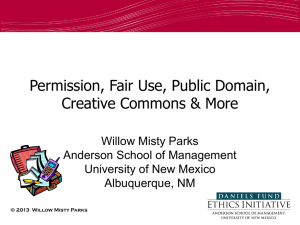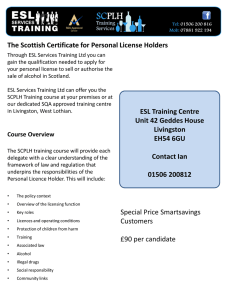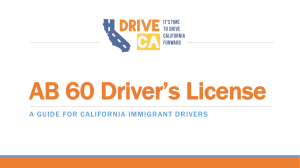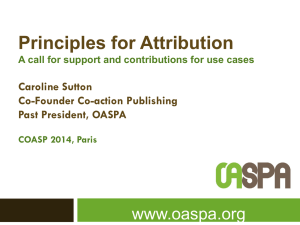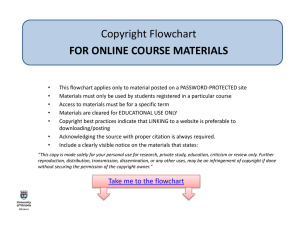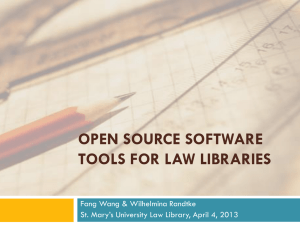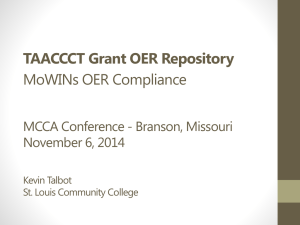Open Source Licensing
advertisement
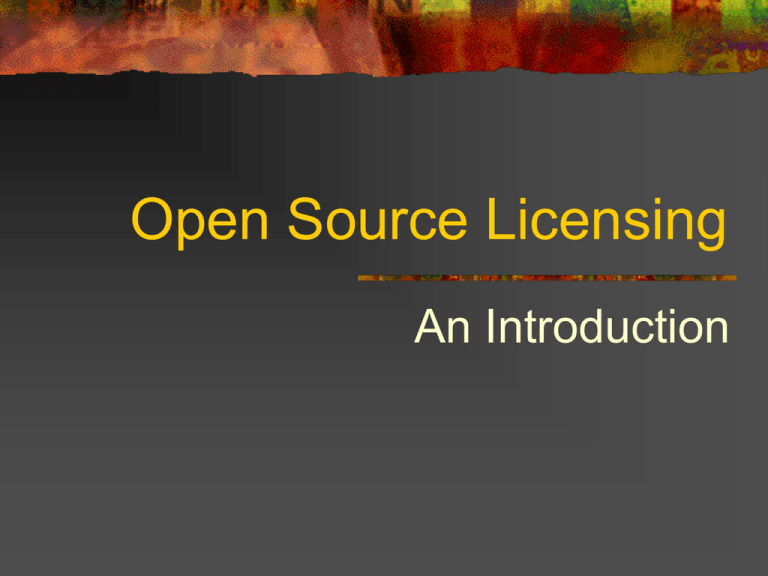
Open Source Licensing An Introduction Presentation outline: Basic intellectual property law (Very) basic software History and philosophy of open source General outline of types of open source licenses Analysis of individual licenses Risks and benefits of open source The open source idea in other contexts Conclusion Part I Basic Intellectual Property Law What is intellectual property? “Intellectual property refers to creations of the mind: inventions, literary and artistic works, and symbols, names, images, and designs used in commerce.” What is Intellectual Property?, World Intellectual Property Organization (WIPO), http://www.wipo.int/about-ip/en/ There are three types of intellectual property 1. Expressions 2. Ideas 3.Unique commercial identifiers Copyright Law Protecting Expressions What is the Legal Basis of Copyright Law? U.S. Const. Art. 1 § 8 Cl. 8. The Copyright Act, 17 U.S.C. §§ 101 et seq. The Berne Convention for the Protection of Literary and Artistic Works What is copyrightable? “[O]riginal works of authorship fixed in any tangible medium of expression, now known or later developed, from which they can be perceived, reproduced, or otherwise communicated, either directly or with the aid of a machine or device.” 17 U.S.C. § 102. How does a work become copyrighted? As soon as a work is fixed in a tangible medium, copyright subsists. What protections does copyright law provide? 17 USC § 106 A copyright holder has the exclusive right: To make copies of the work To prepare derivative works To distribute copies of the original work or derivative works For certain types of works, to perform the work For certain types of works, to perform the work Copies The original is the first copy Any duplicate is a copy All instances of a software program are copies All open source licenses grant the right to make copies There is no limitation on the means made to make a copy Derivative Works “[A] work based upon one or more preexisting works, such as a translation . . . or any other form in which a work may be recast, transformed, or adapted.” 17 U.S.C. § 101. Collective Works “A work . . . in which a number of contributions, constituting separate and independent works in themselves, are assembled into a collective whole.” 17 U.S.C. § 101. Joint Works “A ‘joint work’ is a work prepared by two or more authors with the intention that their contributions be merged into inseparable or interdependent parts of a unitary whole.” 17 U.S.C. § 101. Copyright Chain of Title “The copyright in a compilation or derivative work extends only to the material contributed by the author of such work, and does not imply any exclusive right in the preexisting material. The copyright in such work is independent of, and does not affect or enlarge the scope, duration, ownership, or subsistence of, any copyright protection in the existing material. 17 U.S.C. § 103. Copyright Exceptions for Software The owner of a copy has a right to make a copy; would otherwise be useless The owner of a copy has a right to make a copy for archival purposes. Patent Law Protecting Ideas What is the legal basis for patent law? U.S. Const. Art. 1 § 8 Cl. 8. The U.S. Patent Act, 35 U.S.C. §§ 1 et seq. What is patentable? “[A]ny new and useful process, machine, manufacture, composition of matter, or any new and useful improvement thereof.” 17 U.S.C. § 101 Must be novel, useful, and non obvious and be patentable subject matter. How does a work become patented? Obtaining a patent is difficult and time consuming. An inventor must file a patent application with the patent office in every country in which he or she wishes to have a patent. The patent may be later overturned by a court if it is insufficient. What protections does patent law provide? Gives patent holder right to exclude others from: Making anything with his or her invention Using anything embodying his or her invention Selling or offering to sell anything embodying his or her invention Importing anything embodying his or her invention Copyright Exceptions for Software Owner of a copy has a right to make a copy; would otherwise be useless Owner of a copy has a right to make a copy for archival purposes. See Rosen at 25-26 Patent Chain of Title Only one patent owner for any work There is no open source definition for patent licenses Assigning Ownership Transferring ownership of a copyright, patent or trademark itself, not merely rights associated with it Not usually helpful for open source; an open source license generally provides the same protections that an assignment of ownership would. Trademarks Protecting unique commercial identifiers What is the legal basis for trademark protection? The U.S. Trademark Act, 15 U.S.C. §§ 1501 et seq. The common law What is a trademark? The unique identifying mark that distinguishes the goods or services of one merchant from those of another. What protections does trademark law provide? Keeps other merchants from using another merchant’s unique identifying mark. Licenses What is a license? Grants permission to use a copyrighted work Can grant any or all of the rights associated with copyright Can impose other restrictions, such as type or place or usage, or duration of the license Does not transfer ownership of the copyright Contracts Must have three things: - Offer - Acceptance - Consideration Part II Software Basics Software “[A] general term used to describe a collection of computer programs, procedure and documentation that perform some tasks on a computer system.” Wikipedia. Hardware The physical parts of a computer, as opposed to software, which exists inside the computer There are two types of code for software Object code Source code Source Code “Programming statements created by a programmer.” Kennedy at 2 In human readable form Easy to modify Most license agreements do not allow for access to source code Programmers use a compiler to turn it into object code Object Code Also called executable code “The instruction sequence for the computer processor.” Kennedy at 2. Not human readable Most software is distributed in object code form Part III Open Source Software What is open source software? Open source software is software that is subject to an open source license. An open source licensor must give the licensee certain rights to be considered open source Basically, the licensee has the right to use, modify or distribute the software, and the right to access the source code. Is it the same as free software? Generally yes Free software was the original name Open source began being used to allay the concerns of proprietary software companies that were thinking of utilizing or developing free software Prominent Open Source Programs Apache Web Server Mozilla and Firefox web browsers Linux BIND MySQL Prominent Open Source Vendors IBM Red Hat Sun Microsystems The History of Open Source Richard Stallman, the GNU operating System, the Free Software Foundation, and the General Public License (GPL) Bill Joy, UNIX and the Berkeley Software Distribution License (BSD) Open source comes of age – Linux, Mozilla, Apache et al., and the corporate licenses The Open Source Initiative What are the OSI and the OSD? The Open Source Initiative (OSI) is the de facto standards body for open source software. It determines what open source means, and approves licenses as being open source The Open Source Definition (OSD) is a set of criteria that a license must conform to to be considered open source. The OSI maintains the definition and changes it from time to time. The Open Source Definition 1. Free Redistribution. “The license shall not restrict any party from selling or giving away the software as a component of an aggregate software distribution containing programs from several different sources, The license shall not require royalty or other fee for such sale.” 2. Source Code. “The program must include source code, and must allow distribution in source code as well as compiled form. Where some form of a product is not distributed with source code, there must be a well publicized means of obtaining the source code for no more than a reasonable reproduction cost, preferably, downloading via the Internet without charge. The source code must be the preferred form in which a programmer would modify the program. Deliberately obfuscated source code is not allowed. Intermediate forms such as the output of a preprocessor or translator are not allowed.” 3. Derived Works. “The license must allow modifications and derived works, and must allow them to be distributed under the same terms as the license of the original software.” 4. Integrity of the Author’s Source Code. “The license may restrict source-code from being distributed in modified form only if the license allows the distribution of ‘patch files’ with the source code for the purpose of modifying the program at build time. The license must explicitly permit distribution of software built from modified source code. The license may require derived works to carry a different name or version number from the original software.” 5. No Discrimination Against Persons or Groups. “The license must not discriminate against any person or group of persons.” 6. No Discrimination Against Fields of Endeavor. “The license must not restrict anyone from making use of the program in a specific field of endeavor. For example, it may not restrict the program from being used in a business, or from being used in genetic research” 7. Distribution of License. “The rights attached to the program must apply to all to whom the program is redistributed without the need for execution of an additional license by those parties.” 8. License Must Not Be Specific to a Product. “The rights attached to the program must not depend on the program’s being part of a particular software distribution. If the program is extracted from that distribution and used or distributed within the terms of the program’s license, all parties to whom the program is redistributed should have the same rights as those that are granted in conjunction with the original software distribution.” 9. License Must Not Contaminate Other Software. “The license must not place restrictions on other software that is distributed along with the licensed software. For example, the license must not insist that all other programs distributed on the same medium must be open-source software.” 10. License Must Be Technology Neutral. “No provision of the license may be predicated on any individual technology or style of interface.” Part IV Open Source Licenses In General There are several types of software licenses: The GPL, or “copyleft” family of licenses The BSD/academic family of licenses The Mozilla/corporate type licenses Other open source licenses Traditional proprietary licenses Shareware/freeware Public domain (not a license, but a way of accessing software) The GPL family of licenses Basic rights under the GPL – access to source code, right to make derivative works “Copyleft” The Library or Lesser General Public License The BSD family of licenses Same basic rights as GPL No copyleft provisions, i.e. licensees can take software licensed under the BSD private Can re-release software under a different license Mozilla/corporate licenses More expertly drafted Serve as a model for later commercial licenses Different provisions on relicensing No copyleft Other Open Source Licenses There are over fifty (50) other open source licenses The IBM Common Public License, the MIT X license, and the Artistic License are examples The open source community discourages writing one’s own license in order to prevent license proliferation Shareware/Freeware May be free or may not Licensor does not provide the right to make derivative works or give access to source code Public Domain Author retains no copyright rights if software is in the public domain Open source software authors retain copyright rights Open source licenses contain restrictions, just different ones than licensees may be used to The restrictions in open source licenses are based on copyright law and depend on it for their effectiveness. Part V Some Specific Open Source Licenses The GNU General Public License (GPL) Part license, part manifesto Reciprocity/Copyleft Purpose is to increase amount of publicly available software and ensure compatibility Licensees have right to modify, use or distribute software, and to access the source code Problems with the GPL Linking to GPL programs No explicit patent grant Does no discuss trademark rights Does not discuss duration Silent on sublicensing Relies exclusively on license law, not contract The Library or Lesser General Public License (LGPL) Written to deal with the linking problem in the GPL discussed above Provides that programs that merely link to a program in a library are not subject to copyleft If licensee makes a derivative work of the library, copyleft applies The Berkeley Software Distribution License (BSD) No copyleft/reciprocity provision Does not mention patents Other BSD type academic licenses MIT Apache Artistic License The Mozilla Public License (MPL) Professionally written Includes an explicit patent grant, including a reciprocal grant for contributors Includes many specific provisions that are absent in the GPL and BSD but which are often in licenses. The Common Public License (CPL) Developed and owned by IBM Includes a limited patent license Contains a reciprocity provision Contains a patent defense provision Indemnity provision The Open Source License and the Academic Free License Mirror images of each other, except the AFL does not include reciprocity provisions and the OSL does Addresses aspects of copyright left out by other licenses, such as scope and duration Grants a patent license Retains name and trademark of licensor Multiple Licensing and other strategies Microsoft’s Shared Source License Public Source Multiple Licensing Licensing in phases Part VI Risks and Benefits of Open Source Software Legal Risks Intellectual property infringement No warranties Copyleft Copyright attribution and notice requirements Enforcement Ambiguous license terms Consumer protection laws License management Licenses have not been construed by an American Court Licenses may be revocable Uncertain interpretation Forking (not a legal risk, but still a risk) Benefits Increased user base Longer useful life Increased stability Security Scalability Innovation Cost Adaptability How do licensors make money with open source software? Usually by providing other services, such as: Support Training Customization Integration Certification Offering warranties Part VII The Open Source Idea in Other Contexts Open Content “Describes any kind of creative work published in a format that explicitly allows copying and modifying of its information by anyone, not exclusively by a closed organization, firm, or individual.” From Wikipedia, the world’s largest open source project. Creative Commons Creative Commons Licenses Baseline rights Various Licenses Creative Commons International Other Open Content Organizations Creative Commons International http://creativecommons,org/international/ Science Commons (a Creative Commons Project) http://sceincecommons.org Open Educational Resources Commons (OER) http://www.oercommons.org/ Open Content (http://www.opencontent.org/ For more see the Google Directory, http://www.google.com/Top/Computers/Open_Source/O pen_Content/ (providing a list of websites dedicated to open source) Other open content licenses include: GNU Free Documentation License Open Content License Free Art License Open Game License October Open Game License Considerations before licensing with Creative Commons or other open content license Make sure you understand what rights you are retaining and which ones you are giving up Make sure you own the copyright Make sure your work is subject to copyright law “Be specific about what you are licensing” (creative commons FAQs) Part VII Further Reading LAWRENCE ROSEN , OPEN SOURCE LICENSING: SOFTWARE FREEDOM AND INTELLECTUAL PROPERTY LAW (Prentice Hall Professional and Technical Reference 2004), available at http://www.rosenlaw.com/oslbook.htm. The best book on open source licensing. Gives an in-depth but not overly detailed overview of issues regarding open source licensing. Includes the text of some o the more popular open source licenses and point-by-point analysis of some of the most important licenses. http://www.opensource.org - the online home of the Open Source Initiative, the de facto standards body of the open source movement. Provides a list of and the text of all OSI approved licenses. Sets out the open source principles, answers frequently asked questions, and provides helpful links Dennis M. Kennedy, A Primer on Open Source Licensing Legal Issues: Copyright, Copyleft and Copyfuture, (2001), available at http://www.denniskennedy.com/opensourcedmk.pdf. http://creativecommons.org - the open source idea in non software contexts On the business issues: Eric S. Raymond, The Magic Cauldron, available at http://www.catb.org/~esr/writings/magiccauldron/magic-cauldron.html/, (discussing how to make money on open source) David A. Wheeler, “Why Open Source Software/Free Software (OSS/FS, FLOSS, of FOSS)? Look at the Numbers!,” available at http://www.dwheeler.com/oss_fs_why.html#histo ry (reviewing literature on and discussing the benefits of open source versus proprietary software) Lists of open source projects http://freshmeat.net http://sourceforge.net On open source software generally Eric S. Raymond, The Cathedral and the Bazaar: Musings on Linux and Open Source by an Accidental Revolutionary (O’Reilly Media 2001), available at http://www.catb.org/~esr/writings/cathedral -bazaar/ Part IX Conclusion Like anything else, open source has both risks and benefits (for licensors and licensees) They are neither an unmitigated good, nor particularly dangerous. Before using them, either to license your work or accepting work subject to them, you should evaluate your own situation and make an individual determination. General information cannot take into account your And on a similar note, remember . . . This presentation is not legal advice. Legal advice can only be provided with regards to specific factual circumstances in the context of an attorney-client relationship. This presentation does not establish an attorney-client relationship. If you have any further questions that you are unable to answer yourself after reasonable efforts, contact the Department of Legal Affairs, 304 Holladay Hall, 515-3071
